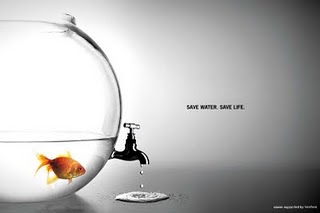Water conservation
Easy Ways to Conserve Water
Have you looked at your water bill lately? Waters no longer cheap!
Taking a few steps each day to reduce the amount of water you use can save thousands of gallons of wasted water each year.
Here’s how:
Turn it off!
We have all developed the bad habit of letting the faucet run while waiting for the shower to warm up, while we brush our teeth, or while we wait for a cold glass of water. Keeping a pitcher of water in the refrigerator or turning the faucet off while we brush our teeth can save several gallons of water each day!
Fix leaky faucets!
There is no such thing as a little drip.
A leaky faucet with a drip of just 1/16 of an inch in diameter (about this big –o–) can waste 10 gallons of water every day. You get rid of that drip by replacing worn washers or valve seats.
The silent leak. Even worse than the careless hand on the faucet is the silent toilet bowl leak, probably the single greatest water waster in homes. A leak of one gallon every 24 minutes—an average amount—totals 2.5 gallons per hour or 60 gallons per day!
To check your toilet for a leak, place a few drops of food coloring in the tank and wait. If the color appears in the bowl, then there’s a leak. Often these leaks can be fixed with a few minor adjustments, cleaning calcium deposits from the toilet ball in the tank, or by replacing worn valves.
Close the hose.
Letting the garden hose run faster or longer than necessary while we water the lawn or wash the car often becomes a careless and wasteful habit. A ½ inch garden hose under normal water pressure pours out more than 600 gallons of water per hour and a ¾ inch hose delivers almost 1,900 gallons in the same length of time.
If left on overnight, one garden hose can easily waste twice as much water as the average family uses in a month.
Irrigate Wisely.
We have all seen the neighbor waters their lawn during an afternoon thunder storm. We have all seen the corner business whose whose automatic sprinkler system consistently over-waters causing sheets of water to flow across sidewalks and parking lots.
Be wise, watch the weather and irrigate only during the cooler parts of the day (early morning or late evening). Adjust your sprinkler heads to water only your lawn.
How do you know if you lawn requires water? Try the step test. If you walk across your lawn and the grass does not spring back up, then it’s time to water. Most grass varieties require minimal watering (1/4 – 1/2 inches, once or twice a week).
Check the plumbing.
Proper maintenance is one of the most effective water savers. Faucet washers are inexpensive and take only a few minutes to replace. At home, check all water taps, hoses, and hose connections (even those that connect to dishwashers and washing machines) for leaks. Check the garden hose too—it should be turned off at the faucet, not just at the nozzle.
Water Conservation: The 5 Minute Shower Challenge.
A quick shower uses around 20-30 gallons less water than a bath. Challenge yourself and your family members to take 5 minute showers. Install a water-saving shower head for additional savings.
~ concord carpenter
Source: groundwater.org


